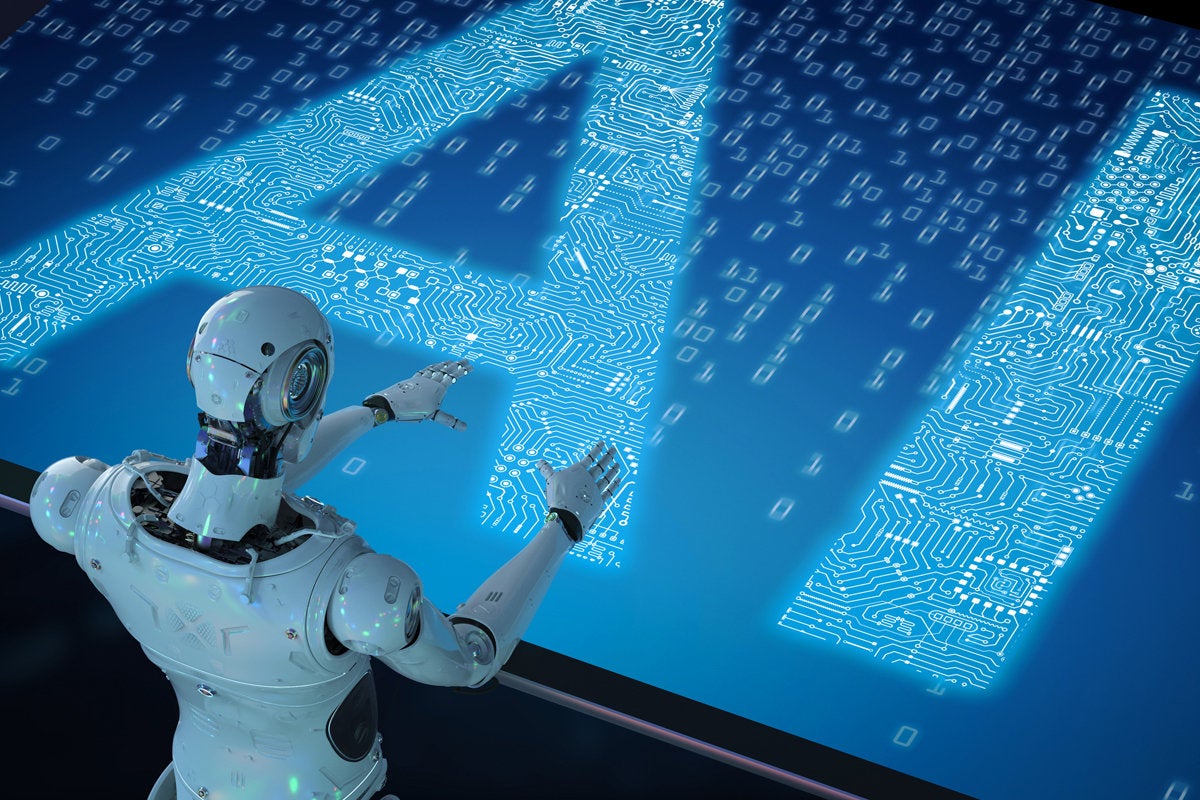The challenges and opportunities presented by AI for programmers are reshaping the software development landscape. This transformative technology presents both exciting possibilities and significant hurdles for programmers, requiring adaptation, upskilling, and a reevaluation of traditional practices. We’ll explore the evolving roles of programmers, the emergence of AI-assisted tools, new programming paradigms, and the critical aspects of data handling and AI model deployment, all while addressing the crucial security and ethical implications.
From the potential displacement of certain programming jobs to the creation of entirely new roles focused on AI development and deployment, the impact is profound and multifaceted. Understanding these changes is crucial for programmers seeking to navigate this evolving technological terrain and capitalize on the opportunities presented by this powerful technology. The future of programming is intrinsically linked to the advancement of AI, demanding a proactive and adaptable approach from professionals in the field.
Job Displacement and Creation: The Challenges And Opportunities Presented By AI For Programmers

The rise of artificial intelligence (AI) presents a complex duality for programmers: the potential for job displacement alongside the creation of entirely new roles. While AI-powered tools can automate certain programming tasks, leading to concerns about job security, they simultaneously open doors to innovative fields requiring specialized skills and expertise. Understanding this dynamic is crucial for programmers navigating the evolving landscape of the tech industry.
AI-driven automation poses a significant threat to certain programming jobs. Repetitive tasks, such as generating boilerplate code or performing basic debugging, are increasingly being handled by AI-powered tools. This automation can lead to reduced demand for programmers specializing in these areas, particularly those with limited experience or specialized skills. The impact will vary across different programming niches, with roles heavily reliant on predictable, repetitive tasks facing the greatest risk.
For example, junior developers primarily focused on front-end development using readily available frameworks might find their tasks increasingly automated. However, it’s important to note that complete replacement is unlikely; human oversight and problem-solving capabilities remain crucial even in highly automated environments.
New Programming Roles Created by AI Technologies
The emergence of AI technologies has spurred the creation of numerous new programming roles. These roles require a deeper understanding of AI algorithms, machine learning models, and data science principles. The demand for professionals who can build, train, and maintain AI systems is rapidly increasing. Examples include AI/ML engineers, data scientists, prompt engineers, and AI ethicists. These roles require a blend of traditional programming skills and a deep understanding of AI principles.
The rapid advancement of AI necessitates continuous learning and adaptation, emphasizing the importance of lifelong learning in this field. The development and deployment of sophisticated AI systems require specialized expertise beyond the scope of traditional programming roles.
Skill Set Comparison: Traditional vs. AI-Related Programming
Traditional programming roles often focus on developing applications using established languages and frameworks. Skills typically include proficiency in languages like Java, Python, C++, and JavaScript, as well as experience with databases and software development methodologies. In contrast, AI-related programming roles demand a broader skill set encompassing machine learning algorithms, deep learning frameworks (TensorFlow, PyTorch), data manipulation and analysis techniques, and a strong understanding of statistical modeling.
While proficiency in traditional programming languages remains valuable, the ability to work with large datasets, build and deploy machine learning models, and understand ethical implications of AI are paramount in these new roles. The ability to interpret and communicate complex technical information to non-technical stakeholders is also becoming increasingly important.
Job Categories at Risk and Newly Created
| Job Category | Risk Level | Required Skills | Projected Growth |
|---|---|---|---|
| Junior Front-End Developer (basic framework implementation) | High | HTML, CSS, JavaScript (basic frameworks) | Low |
| Data Entry Clerk (routine data processing) | High | Data entry skills, basic computer literacy | Low |
| AI/ML Engineer | Low | Python, TensorFlow/PyTorch, Machine Learning algorithms, Data Science | High |
| Prompt Engineer | Low | Natural Language Processing (NLP), Large Language Models (LLMs), creative writing skills | High |
| Senior Software Engineer (complex systems) | Medium | Multiple programming languages, software architecture, system design | Medium |
| Cybersecurity Analyst (AI-focused) | Low | Cybersecurity principles, AI/ML security, threat detection | High |
AI-Assisted Programming Tools

The rise of artificial intelligence has profoundly impacted the software development landscape, ushering in a new era of AI-assisted programming tools. These tools leverage machine learning algorithms to automate various programming tasks, boosting programmer productivity and potentially reshaping the software development process itself. This section explores the capabilities, limitations, and ethical considerations surrounding these increasingly sophisticated tools.AI-powered tools are transforming how programmers work, offering assistance across the entire software development lifecycle.
These tools are not meant to replace programmers but to augment their capabilities, allowing them to focus on more complex and creative aspects of software design.
Code Completion and Suggestion Tools
Numerous AI-powered code completion tools are available, significantly reducing the time programmers spend writing boilerplate code. These tools analyze the code context, predict the next lines of code, and suggest relevant functions or libraries. GitHub Copilot, Tabnine, and Kite are prominent examples. These tools learn from vast datasets of code, allowing them to suggest highly accurate and contextually relevant code snippets.
This accelerates development, minimizes errors arising from repetitive typing, and frees programmers to concentrate on higher-level design and problem-solving. For instance, a programmer working on a web application might use Copilot to suggest efficient methods for handling user authentication or database interactions, saving significant development time.
AI-Powered Debugging Tools
Debugging, a notoriously time-consuming aspect of software development, is also being revolutionized by AI. Tools like DeepCode and Code Climate analyze code for potential bugs and vulnerabilities, often identifying issues that might escape human scrutiny. These tools leverage machine learning models trained on massive codebases to detect patterns associated with common errors. By flagging potential problems early in the development process, these tools reduce debugging time and improve software quality.
For example, an AI-powered debugger might identify a potential null pointer exception or a memory leak before the code is even deployed, preventing costly runtime errors and improving application stability.
Automated Testing and Quality Assurance
AI is also enhancing automated testing processes. Tools utilize machine learning to generate test cases automatically, covering a broader range of scenarios than manual testing alone. This improves code coverage and reduces the likelihood of undetected bugs. Moreover, AI can analyze test results to identify patterns and pinpoint areas of the code that require further attention. This reduces the time and effort required for comprehensive testing, leading to higher quality software.
For example, an AI-powered testing tool could automatically generate unit tests for a new function, ensuring that it behaves as expected under various input conditions.
Limitations and Potential Biases of AI-Assisted Programming Tools
While AI-assisted programming tools offer significant advantages, they also have limitations. One key limitation is their reliance on the data they are trained on. If the training data contains biases (e.g., favoring certain coding styles or neglecting certain programming languages), the AI tool may perpetuate or even amplify these biases in its suggestions. Furthermore, these tools may not always generate optimal or even correct code, requiring human oversight and verification.
The complexity of software systems often necessitates human expertise to address nuanced situations and solve complex problems that AI might struggle with. Over-reliance on AI tools without critical evaluation can lead to errors and hinder the development of robust and secure software.
Ethical Considerations in AI-Assisted Software Development
The automation of software development raises several ethical considerations. Concerns include the potential for job displacement, the responsibility for errors generated by AI tools, and the potential for AI to exacerbate existing biases in software systems. Ensuring fairness, transparency, and accountability in the development and deployment of AI-assisted programming tools is crucial. Careful consideration should be given to the impact on human programmers, ensuring that AI tools are used to augment, not replace, human expertise.
Furthermore, developers must be mindful of the potential for AI to introduce biases into software, potentially leading to discriminatory or unfair outcomes. Establishing clear guidelines and ethical frameworks for the development and use of AI in software engineering is essential to mitigate these risks.
New Programming Paradigms
The rise of artificial intelligence is fundamentally reshaping the landscape of programming, ushering in new paradigms that demand a shift in skills and approaches from traditional software development. These changes are not merely incremental improvements; they represent a paradigm shift, requiring programmers to adapt to new tools, methodologies, and ways of thinking about problem-solving. The integration of AI into programming is not just about automating tasks; it’s about creating systems that learn, adapt, and evolve.AI’s influence is driving the development of novel programming approaches, significantly altering how software is designed, developed, and deployed.
This necessitates a deeper understanding of machine learning frameworks and the burgeoning field of natural language programming, alongside the challenges inherent in mastering these new methodologies.
Emerging Programming Paradigms Influenced by AI
AI is fueling the evolution of several programming paradigms. Machine learning frameworks, such as TensorFlow and PyTorch, have become indispensable tools for building AI-powered applications. These frameworks provide high-level abstractions, allowing developers to focus on model design and training rather than low-level implementation details. Meanwhile, natural language programming (NLP) aims to bridge the gap between human language and computer code, enabling developers to write programs using natural language instructions.
While still in its early stages, NLP holds immense potential for democratizing programming and making it accessible to a wider audience. The adoption of these frameworks and the development of NLP-driven tools are significantly impacting how software is built and deployed. For example, the use of autoML tools allows individuals with limited coding expertise to build machine learning models, significantly expanding the potential pool of AI developers.
Challenges of Adapting to New Paradigms
Transitioning from traditional programming to AI-focused paradigms presents several significant challenges. Firstly, the mathematical and statistical foundations of machine learning are often quite complex, requiring a strong understanding of linear algebra, calculus, and probability. Secondly, the iterative nature of machine learning model development demands a different mindset compared to traditional software development, where the focus is often on building a complete and deterministic system.
Debugging and optimizing AI models can also be considerably more challenging than debugging traditional code, often requiring extensive experimentation and hyperparameter tuning. Finally, the rapid pace of innovation in the field means continuous learning and adaptation are essential for staying current. For instance, the constant evolution of deep learning architectures and the emergence of new machine learning techniques require programmers to continuously update their knowledge and skills.
Complexity Comparison: Traditional vs. AI-Focused Languages
Traditional programming languages like C++, Java, and Python (in its non-AI contexts) emphasize explicit instructions and deterministic execution. Their learning curves, while varying in steepness, generally involve mastering syntax, data structures, and algorithms. AI-focused languages and frameworks, on the other hand, often involve a steeper learning curve due to the underlying mathematical complexities and the need to understand statistical modeling concepts.
While Python remains popular for AI development due to its extensive libraries, mastering frameworks like TensorFlow or PyTorch requires a deeper understanding of machine learning principles than simply writing procedural or object-oriented code. The shift requires a change from focusing primarily on explicit instructions to understanding and manipulating probabilistic models.
Key Differences Between Traditional and AI-Driven Programming Paradigms
The following points highlight the key distinctions between traditional and AI-driven programming approaches:
- Programming Style: Traditional programming emphasizes imperative or declarative approaches, specifying exact steps. AI-driven programming often involves specifying goals and letting the AI system find the optimal solution.
- Execution: Traditional programs execute deterministically, producing the same output for the same input. AI models exhibit probabilistic behavior, producing outputs based on learned patterns and statistical distributions.
- Debugging: Debugging traditional code involves tracing execution flow and identifying logic errors. Debugging AI models often involves analyzing model performance metrics, identifying biases, and tuning hyperparameters.
- Data Dependence: Traditional programs operate on defined inputs. AI models learn from data and their performance is heavily reliant on data quality and quantity.
- Focus: Traditional programming focuses on algorithmic efficiency and correctness. AI-driven programming focuses on model accuracy, generalization, and robustness.
Data Handling and Management

The rise of artificial intelligence (AI) has dramatically increased the importance of robust data handling and management skills for programmers. AI algorithms, particularly machine learning models, are fundamentally data-driven. The quality, quantity, and accessibility of data directly impact the performance and reliability of AI systems. Programmers are no longer simply coding; they are now data engineers, wranglers, and analysts, tasked with preparing and managing the lifeblood of intelligent applications.The sheer volume and complexity of datasets used in modern AI applications pose significant challenges.
We are dealing with petabytes of data, often unstructured or semi-structured, originating from diverse sources and formats. Efficiently storing, accessing, and processing this data requires specialized skills and tools. The challenge extends beyond simple storage; effective data management also encompasses version control, data governance, security, and compliance with relevant regulations. Failure at any of these stages can lead to inaccurate model training, biased results, or even catastrophic system failures.
Data Cleaning, Preprocessing, and Analysis Techniques
Data cleaning involves identifying and correcting or removing inaccurate, incomplete, irrelevant, or duplicated data. Common techniques include handling missing values (imputation or removal), outlier detection and treatment, and data transformation (e.g., normalization, standardization). Preprocessing focuses on transforming raw data into a format suitable for AI algorithms. This often involves feature scaling, feature selection or extraction, and encoding categorical variables.
Data analysis, in the context of AI, involves exploratory data analysis (EDA) to understand data characteristics, identify patterns, and validate assumptions before model building. Techniques like principal component analysis (PCA) and t-distributed stochastic neighbor embedding (t-SNE) are used for dimensionality reduction and visualization, enabling better understanding of complex datasets.
Data Structures and Algorithms for AI
Efficient data structures are crucial for managing the computational demands of AI applications. Arrays, linked lists, and trees are fundamental, but specialized structures like hash tables (for fast data lookup) and graphs (for representing relationships between data points) are often employed. Furthermore, the choice of algorithm significantly impacts performance. For example, when training machine learning models, algorithms like gradient descent are fundamental, while algorithms like k-means clustering are used for unsupervised learning tasks.
The choice of algorithm and data structure depends heavily on the specific AI task, the size and nature of the dataset, and the available computational resources. For instance, sparse matrices are highly efficient for handling large datasets with many missing values, common in natural language processing or recommendation systems. Conversely, dense matrices are more suitable for tasks where all data points are relevant and require frequent access.
AI Model Development and Deployment
The development and deployment of AI models represent a crucial stage in leveraging artificial intelligence for practical applications. This process involves a complex interplay of data preparation, model selection, training, optimization, and finally, integration into a target environment. Understanding the nuances of each step is paramount for successful AI implementation, regardless of the specific application.The process of developing and deploying AI models is iterative and often requires significant experimentation.
Challenges arise at every stage, from data acquisition and preprocessing to model selection and deployment across diverse platforms. Effective strategies for overcoming these hurdles are vital for achieving optimal model performance and scalability.
Model Training and Optimization, The challenges and opportunities presented by AI for programmers
Model training involves feeding large datasets to an algorithm, allowing it to learn patterns and relationships. The goal is to minimize prediction error and achieve high accuracy. Optimization techniques, such as hyperparameter tuning and regularization, are employed to enhance model performance and prevent overfitting. For instance, a model trained on biased data might yield inaccurate predictions; therefore, rigorous data cleaning and preprocessing are crucial.
Optimization also addresses computational efficiency; a complex model might require significant resources, leading to long training times and high computational costs. Finding the optimal balance between model complexity and computational efficiency is a key challenge.
Deployment Strategies and Trade-offs
Various deployment strategies exist, each with its own set of trade-offs. Cloud-based deployment offers scalability and accessibility but introduces latency and dependency on internet connectivity. On-premise deployment provides greater control and security but necessitates significant infrastructure investment. Edge deployment, where models run on devices close to the data source, minimizes latency but limits computational resources. The choice of deployment strategy depends on factors such as scalability requirements, latency tolerance, security concerns, and available resources.
For example, a real-time application like autonomous driving necessitates edge deployment to minimize latency, while a batch processing task might be better suited for cloud deployment.
AI Model Deployment Process Flowchart
This flowchart Artikels the key steps involved in developing and deploying an AI model.
1. Data Acquisition and Preprocessing
Gathering and cleaning the data, handling missing values, and transforming data into a suitable format for model training. This step is critical for ensuring the quality and reliability of the model.
2. Model Selection and Training
Choosing an appropriate model architecture based on the problem and data characteristics, then training the model using the prepared data. This involves selecting appropriate algorithms and hyperparameters.
3. Model Evaluation and Optimization
Assessing the model’s performance using various metrics and techniques. Optimization involves fine-tuning hyperparameters and potentially retraining the model to improve accuracy and efficiency.
4. Model Deployment
Choosing a deployment strategy (cloud, on-premise, edge) and deploying the model to the target environment. This often involves integrating the model into existing systems and infrastructure.
5. Monitoring and Maintenance
Continuously monitoring the model’s performance and making necessary adjustments or retraining as needed. This ensures the model remains accurate and effective over time.
Security and Ethical Implications
The integration of Artificial Intelligence (AI) into software development presents a double-edged sword. While offering unprecedented opportunities for innovation and efficiency, it also introduces significant security risks and complex ethical dilemmas that demand careful consideration. Failing to address these concerns could lead to widespread vulnerabilities and societal harm. This section will delve into the key security risks associated with AI-powered systems and explore the crucial ethical considerations involved in their development and deployment.AI-powered software and systems introduce new attack vectors and vulnerabilities that traditional software does not.
The complexity of AI algorithms, coupled with the reliance on vast datasets for training, creates opportunities for malicious actors to exploit weaknesses. Furthermore, the increasing autonomy of AI systems raises concerns about their potential for unintended consequences and misuse. Responsible development and deployment practices are paramount to mitigate these risks and ensure the ethical use of this powerful technology.
Security Risks Associated with AI-Powered Systems
AI systems, due to their inherent complexity and reliance on data, are susceptible to various security threats. These threats range from data poisoning attacks, where malicious actors manipulate training data to compromise the system’s accuracy and functionality, to adversarial attacks, which involve subtly altering input data to cause the AI to make incorrect predictions or take undesirable actions. Additionally, the potential for unauthorized access to sensitive data used in training or utilized by the AI system itself presents a significant risk.
For example, a self-driving car’s AI system, if compromised, could be manipulated to cause accidents or even be used for malicious purposes. Robust security measures, including data encryption, access controls, and regular security audits, are essential to protect AI systems from these threats.
Ethical Considerations in AI Software Development
The use of AI in software development raises significant ethical concerns, primarily revolving around bias and fairness. AI algorithms are trained on data, and if this data reflects existing societal biases, the resulting AI system will likely perpetuate and even amplify those biases. For instance, facial recognition systems trained on datasets predominantly featuring individuals from one ethnic group may perform poorly on individuals from other groups, leading to discriminatory outcomes.
Ensuring fairness and mitigating bias requires careful attention to data selection, algorithm design, and ongoing monitoring of AI system performance. Transparency in AI development and deployment is also crucial to build trust and accountability.
Responsible AI Development and Deployment
Responsible AI development and deployment necessitate a multi-faceted approach encompassing security, ethical considerations, and legal compliance. This includes establishing clear guidelines and standards for AI development, implementing rigorous testing and validation procedures, and ensuring transparency and explainability in AI decision-making processes. Furthermore, ongoing monitoring and evaluation of AI systems are critical to identify and address potential biases and security vulnerabilities.
Collaboration between developers, ethicists, policymakers, and the wider community is crucial to foster a responsible and ethical AI ecosystem. A commitment to continuous learning and adaptation is necessary to navigate the ever-evolving landscape of AI technology and its implications.
Security Vulnerabilities and Ethical Concerns in AI
| Vulnerability/Concern | Impact | Mitigation Strategies | Responsible Practices |
|---|---|---|---|
| Data Poisoning | Compromised model accuracy, incorrect predictions, biased outputs | Robust data validation, anomaly detection, secure data storage | Transparent data sourcing, rigorous data cleaning and preprocessing |
| Adversarial Attacks | System malfunction, incorrect classifications, security breaches | Adversarial training, input sanitization, robust model architecture | Thorough testing and validation, continuous monitoring for anomalies |
| Bias and Discrimination | Unfair or discriminatory outcomes, perpetuation of societal biases | Diverse and representative datasets, bias detection and mitigation techniques | Regular audits for bias, commitment to fairness and inclusivity |
| Privacy Violations | Unauthorized access to sensitive data, loss of user trust | Data anonymization, encryption, access control mechanisms | Compliance with privacy regulations, informed consent from users |
| Lack of Transparency and Explainability | Difficulty in understanding AI decisions, reduced accountability | Explainable AI (XAI) techniques, model interpretability methods | Openness about AI algorithms and decision-making processes |
Last Word

The integration of AI into programming is not simply a technological advancement; it’s a paradigm shift demanding adaptability and a willingness to embrace new skills. While the potential for job displacement exists, the opportunities for innovation and the creation of entirely new programming roles are equally significant. By understanding the challenges, embracing new paradigms, and prioritizing ethical considerations, programmers can position themselves to thrive in this rapidly evolving landscape.
The future belongs to those who can effectively leverage AI to solve complex problems and build innovative solutions.

